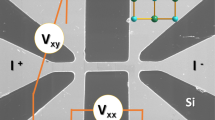Abstract
The theoretical model of conductivity of a layered anisotropic normal metal containing small superconducting ellipsoidal granules with an arbitrary ratio of semiaxes is developed. Calculation data obtained under two simple approximations (self-consistent and Maxwell) are compared. The results may be applied in the analysis of the observed temperature dependence of the conductivity anisotropy in various anisotropic superconductors with the superconducting phase emerging in the form of isolated superconducting granules. The temperature dependence of the electric resistance along and across the conducting layers above and near the superconducting transition temperature is studied experimentally for bridge structures of a varying thickness. It is demonstrated that this resistance and even the effective superconducting transition temperature depend strongly on the bridge thickness (i.e., the number of layers through which the electric current flows). Note that significant differences were observed only for the resistance across the layers.

Similar content being viewed by others
Notes
Ai is always smaller than unity, since \(\sum\nolimits_i {{{A}_{i}}} \) = 1 and Ai > 0 [19]. Therefore, condition ϕs\( \ll \)Ai is more stringent than condition ϕs \( \ll \) 1 of applicability of the Maxwell approximation.
REFERENCES
K. Jung, Met. Mater. 2, 219 (1996).
G. Blumberg, M. Kang, M. V. Klein, K. Kadowaki, and C. Kendziora, Science (Washington, DC, U. S.) 278, 1427 (1997).
K. A. Müller, J. Phys.: Condens. Matter 19, 251002 (2007).
B. Keimer, S. A. Kivelson, M. R. Norman, R. Uchida, and J. Zaanen, Nature (London, U.K.) 518, 965 (2015).
M. Rotter, M. Pangerl, M. Tegel, and D. Johrendt, Angew. Chem. 47, 7949 (2008).
J.-H. Chu, J. G. Analytis, C. Kucharczyk, and I. R. Fisher, Phys. Rev. B 79, 014506 (2009).
Q. Si, R. Yu, and E. Abrahams, Nat. Rev. Mater. 1, 16017 (2016).
V. Z. Kresin, Y. N. Ovchinnikov, and S. A. Wolf, Phys. Rep. 431, 231 (2006).
A. A. Sinchenko, P. D. Grigoriev, A. P. Orlov, A. V. Frolov, A. Shakin, D. A. Chareev, O. S. Volkova, and A. N. Vasiliev, Phys. Rev. B 95, 165120 (2017).
I. Iguchi, T. Yamaguchi, and A. Sugimoto, Nature (London, U.K.) 412, 420 (2001).
I. Martin, D. Podolsky, and S. A. Kivelson, Phys. Rev. B 72, 060502 (2005).
P. D. Grigoriev, A. A. Sinchenko, K. K. Kesharpu, A. Shakin, T. I. Mogilyuk, A. P. Orlov, A. V. Frolov, D. S. Lyubshin, D. A. Chareev, O. S. Volkova, and A. N. Vasiliev, JETP Lett. 105, 786 (2017).
K. K. Kesharpu, P. D. Grigoriev, D. I. Lazeva, and T. I. Mogilyuk, J. Phys.: Conf. Ser. 1238, 012010 (2019). https://doi.org/10.1088/1742-6596/1238/1/012010.
R. Landauer, AIP Conf. Proc. 40, 2 (1978).
S. Torquato, Random Heterogeneous Materials: Microstructure and Macroscopic Properties (Springer, New York, 2002).
S. S. Seidov, K. K. Kesharpu, P. I. Karpov, and P. D. Grigoriev, Phys. Rev. B 98, 014515 (2018).
S. Medvedev, T. M. McQueen, I. A. Troyan, T. Palasyuk, M. I. Eremets, R. J. Cava, S. Naghavi, F. Casper, V. Ksenofontov, G. Wortmann, and C. Felser, Nat. Mater. 8, 630 (2009).
J. F. Ge, Z. L. Liu, C. Liu, C. L. Gao, D. Qian, Q. K. Xue, Y. Liu, and J. F. Jia, Nat. Mater. 14, 285 (2015).
Yu. G. Naidyuk, G. Fuchs, D. A. Chareev, and A. N. Vasiliev, Phys. Rev. B 93, 144515 (2016).
S. Giordano, J. Electrostat. 58, 59 (2003).
N. Kang, B. Salameh, P. Auban-Senzier, D. Jerome, C. R. Pasquier, and S. Brazovskii, Phys. Rev. B 81, 100509(R) (2010).
Funding
T.I. Mogilyuk acknowledges support from the Russian Foundation for Basic Research (grant nos. 18-02-01022, 18-02-00280, 18-32-00205, and 19-02-01000). The work of P.D. Grigoriev was supported by state task no. 0033-2019-0001 “Development of Theory of Condensed Matter.” This study was supported in part by the BASIS Foundation for the Advancement of Theoretical Physics and Mathematics. A.A. Sinchenko acknowledges support from the Russian Foundation for Basic Research (grant no. 17-29-10007). The work of A.V. Frolov and A.P. Orlov was supported by the state task for the Kotel’nikov Institute of Radio Engineering and Electronics.
Author information
Authors and Affiliations
Corresponding author
Ethics declarations
The authors declare that they have no conflicts of interest.
Additional information
Translated by D. Safin
Rights and permissions
About this article
Cite this article
Mogilyuk, T.I., Grigoriev, P.D., Kesharpu, K.K. et al. Excess Conductivity of Anisotropic Inhomogeneous Superconductors Above the Critical Temperature. Phys. Solid State 61, 1549–1552 (2019). https://doi.org/10.1134/S1063783419090166
Received:
Revised:
Accepted:
Published:
Issue Date:
DOI: https://doi.org/10.1134/S1063783419090166



